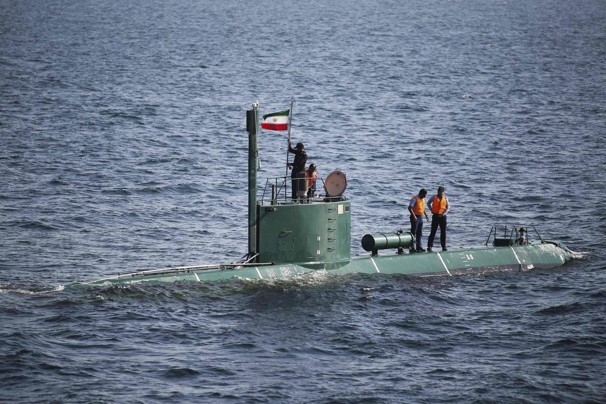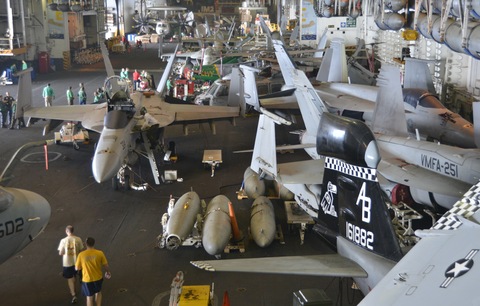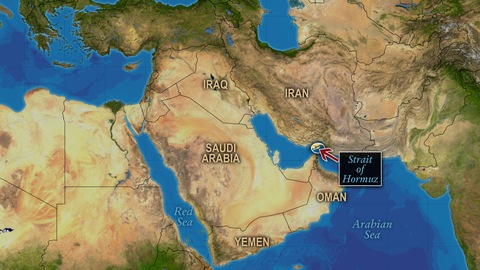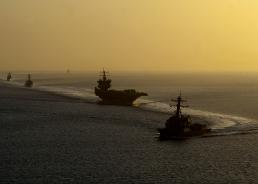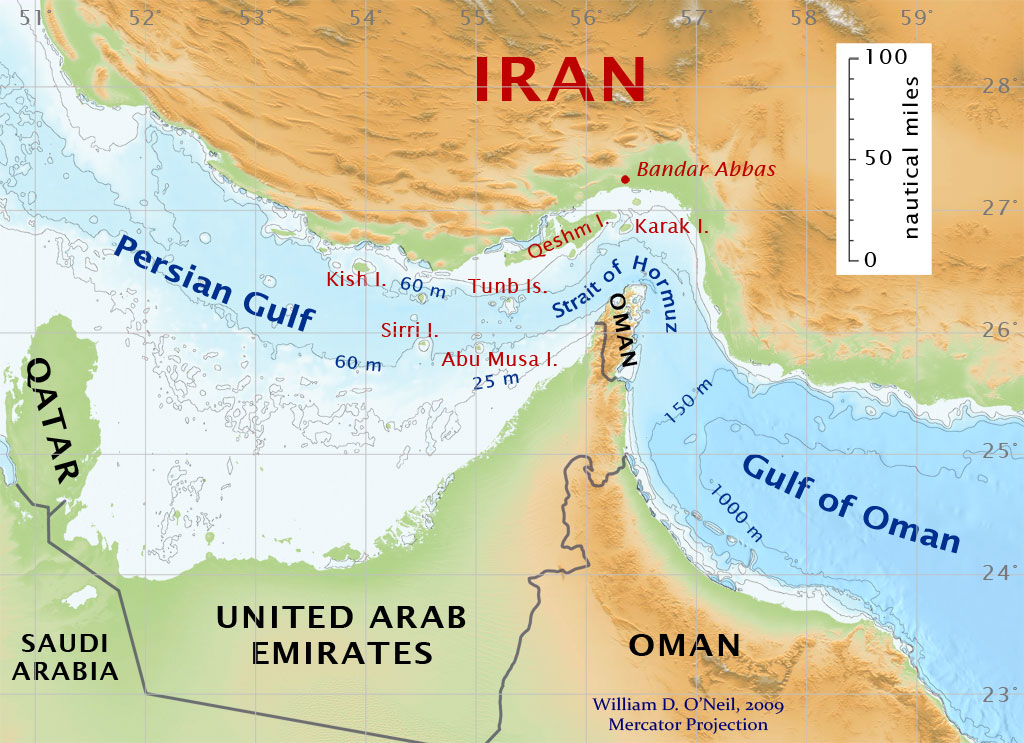
THIS IS WHY THEY ARE HERE
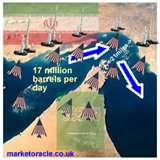
Dee Finney's blog
start date July 20, 2011
Today's date January 28, 2012
updated 10-18-12
page 118
TOPIC: STRAIT OF HORMUZ VS THE USS ENTERPRISE, USS ABRAHAM
LINCOLN AND ANY OTHER SHIP YOU CARE TO NAME.
REMEMBER WHEN WE WERE KIDS, AND WE WATCHED MOVIES WITH ROY ROGERS, HOPALONG
CASSIDY, AND THE LONE RANGER? THE BAD GUY FOUGHT THE GOOD GUY IN AN UPPER
ROOM OF SOME BAR IN A SMALL TOWN AND THE WINNER THEN JUMPED OUT OF THE WINDOW
ONTO HIS FAVORITE HORSE TIED UP IN A POSITION WHERE HE COULD LAND RIGHT ON THE
SADDLE AND RIDE AWAY INTO THE SUNSET. THAT CAN'T HAPPEN ANYMORE. NOW
WE WATCH VIDEOS LIKE THIS ONE:
LETS START OUT WITH WHERE THE STRAIT OF HORMUZ ARE AND WHY THEY
ARE SO IMPORTANT RIGHT NOW
The Strait of Hormuz
/hɔrˈmuːz/ (Arabic:
مَضيق هُرمُز Maḍīq Hurmuz,
Persian: تَنگِه هُرمُز Tangeh-ye
Hormoz) is a narrow, strategically important
strait between
the
Gulf of Oman in the southeast and the
Persian
Gulf. On the north coast is
Iran and on the
south coast is the
United Arab Emirates and
Musandam, an
exclave of Oman.
The strait
at its narrowest is 54 kilometres (34 mi) wide.[1]
It is the only sea passage to the open ocean for large areas of the
petroleum-exporting
Persian
Gulf and is one of the world's most strategically important
choke
points.[2]
Ships moving through the Strait follow a
Traffic Separation Scheme (TSS), which separates inbound from outbound
traffic to reduce the risk of collision. The traffic lane is six miles (10 km)
wide, including two two-mile (3 km)-wide traffic lanes, one inbound and one
outbound, separated by a two-mile (3 km) wide separation median.
To traverse the Strait, ships pass through the territorial waters of Iran and
Oman under the
transit passage provisions of the
United Nations Convention on the Law of the Sea.[1]
Although not all countries have ratified the convention,[3]
most countries, including the U.S.,[4]
accept these customary navigation rules as codified in the Convention. Oman has
a radar site Link Quality Indicator (LQI) to monitor the TSS in the strait of
Hormuz. This site is located on a small island on the peak of
Musandam Peninsula.
[edit]
Traffic Statistics
On an average day in 2011, about 14 tankers carrying 17 million barrels
(2,700,000 m3) of crude oil passed out of the Persian Gulf through
the Strait. This represents 35% of the world's seaborne oil shipments, and 20%
of oil traded worldwide. More than 85 percent of these crude oil exports went to
Asian markets, with Japan, India, South Korea, and China representing the
largest destinations.[2]
[edit]
Etymology
The opening to the Persian Gulf was described, but not given a name, in the
Periplus of the Erythraean Sea, a 1st-century mariner's guide:
"At the upper end of these Calaei islands is a range of mountains called
Calon, and there follows not far beyond, the mouth of the Persian Gulf,
where there is much diving for the pearl-mussel. To the left of the
straits are great mountains called Asabon, and to the right there rises
in full view another round and high mountain called Semiramis; between
them the passage across the strait is about six hundred stadia; beyond
which that very great and broad sea, the Persian Gulf, reaches far into
the interior. At the upper end of this gulf there is a market-town
designated by law called Apologus, situated near Charaex Spasini and the
River Euphrates."
—Periplus of the Erythraean Sea, Chapter 35
Compare the
Pillars of Hercules at the entrance to the Mediterranean. Scholars,
historians and linguists derive[5]
the name "Ormuz" from the local
Persian word هورمغ Hur-mogh
meaning date palm.[6]
In the local dialects of Hurmoz and Minab this strait is still called Hurmogh
and has the aforementioned meaning. The resemblance of this word with the name
of the Persian God هرمز Hormoz (a
variant of
Ahura
Mazda) has resulted in the popular belief that these words are related.
Operation Praying
Mantis
On 18 April 1988, the U.S. Navy waged a one-day battle against Iranian forces
in and around the strait. The battle, dubbed
Operation Praying Mantis by the U.S. side, was launched in retaliation for
the 14 April mining of the
USS Samuel B. Roberts (FFG-58) by Iran. U.S. forces sank one
frigate, one
gunboat, and as many as six armed speedboats in the engagement and seriously
damaged a second frigate.
[edit]
The downing of Iran
Air 655
On 3 July 1988, 290 people were killed when an
Iran Air
Airbus
A300 passenger jet was shot down over the strait by the
United States Navy
guided missile
cruiser
USS Vincennes in a case of ”mistaken identity". The commander of the
USS Vincennes later received an award from the U.S. government which angered the
families of the passengers who were killed.
[edit]
Collision between USS Newport News and tanker Mogamigawa
On 10 January 2007, the nuclear submarine
USS Newport News, traveling submerged, struck M/V Mogamigawa,
a 300,000-ton Japanese-flagged very large crude
tanker, south of the strait.[7]
There were no injuries, and no oil leaked from the tanker.
[edit]
Tensions in 2008
[edit]
2008 US-Iranian
naval dispute
A series of naval stand-offs between Iranian speedboats and U.S. warships in
the Strait of Hormuz occurred in December 2007 and January 2008. U.S. officials
accused Iran of harassing and provoking their naval vessels; Iranian officials
denied these allegations. On 14 January 2008, U.S. naval officials appeared to
contradict the Pentagon version of the 16 January event, in which U.S. officials
said U.S. vessels were near to firing on approaching Iranian boats. The Navy's
regional commander, Vice Admiral
Kevin Cosgriff, said the Iranians had "neither anti-ship missiles nor
torpedoes" and that he "wouldn't characterize the posture of the US 5th Fleet as
afraid of these small boats".[8]
Iranian defence policy
On 29 June 2008, the commander of
Iran's Revolutionary Guard, Ali Mohammed Jafari, said that if Iran were
attacked by Israel or the United States, it would seal off the Strait of Hormuz,
to wreak havoc in oil markets. This statement followed other more ambiguous
threats from Iran's oil minister and other government officials that a Western
attack on Iran would result in turmoil in oil supply.
In response, Vice Admiral Kevin Cosgriff, commander of the U.S. 5th Fleet
stationed in Bahrain across the Persian Gulf from Iran, warned that such an
action by Iran would be considered an act of war, and that the U.S. would not
allow Iran to effectively hold hostage nearly a third of the world's oil supply.[9]
On 8 July 2008, Ali Shirazi, a mid-level clerical aide to Iran's Supreme
Leader
Ayatollah Ali Khamenei, was quoted by the student news agency
ISNA as saying to
Revolutionary Guards, "The Zionist regime is pressuring White House officials to
attack Iran. If they commit such a stupidity, Tel Aviv and U.S. shipping in the
Persian Gulf will be Iran's first targets and they will be burned."[10]
Naval activity in 2008
In the last week of July 2008, in the Operation Brimstone,[11]
dozens of U.S. and foreign navy ships came to off the eastern coast in the U.S.,
to undergo joint exercises for possible military activity in the shallow waters
off the coast of Iran.
As of 11 August 2008, more than 40 U.S. and allied ships reportedly were en
route to the Strait of Hormuz. One U.S. carrier battle group from Japan would
complement two more, which are already in the Persian Gulf, for a total of five
battle groups, not counting submarines.[12]
Collision between USS Hartford and USS New Orleans
On 20 March 2009,
United States Navy
Los Angeles-class
submarine
USS Hartford (SSN-768) collided with the
San Antonio-class
amphibious transport dock
USS New Orleans (LPD-18) in the strait. The collision, which slightly
injured 15 sailors aboard the Hartford, ruptured a fuel tank aboard the New
Orleans, spilling 25,000 US gallons (95 m3) of marine diesel fuel.[13]
Tensions in
2011–2012
On 27 December 2011, Iranian
Vice President
Mohammad-Reza Rahimi threatened to cut off oil supply from the Strait of
Hormuz should economic sanctions limit, or cut off, Iranian oil exports.[14]
A
U.S. Fifth Fleet spokeswoman said in response that the Fleet was "always
ready to counter malevolent actions", whilst Admiral Habibollah Sayari of the
Iranian navy claimed that cutting off oil shipments would be "easy".[15]
Despite an initial 2% rise in oil prices, oil markets ultimately did not react
significantly to the Iranian threat, with oil analyst Thorbjoern Bak Jensen of
Global Risk Management concluding that "they cannot stop the flow for a longer
period due to the amount of U.S. hardware in the area".[16]
On 3 January 2012, Iran threatened to take action if the U.S. Navy moves an
aircraft carrier back into the Persian Gulf. Iranian Army chief Ataollah Salehi
said the United States had moved an aircraft carrier out of the Gulf because of
Iran's naval exercises, and Iran would take action if the ship returned. "Iran
will not repeat its warning...the enemy's carrier has been moved to the
Gulf of
Oman because of our drill. I recommend and emphasize to the American carrier
not to return to the Persian Gulf", he said.[17]
The U.S. Navy spokesman Commander Bill Speaks quickly responded that
deployment of U.S. military assets would continue as has been the custom
stating: "The U.S. Navy operates under international maritime conventions to
maintain a constant state of high vigilance in order to ensure the continued,
safe flow of maritime traffic in waterways critical to global commerce."[18]
While earlier statements from Iran had little effect on global oil markets,
coupled with the new sanctions, these terse comments from Iran are driving crude
futures higher, up over 4%. Pressure on prices reflect a combination of
uncertainty driven further by China’s recent response – reducing oil January
2012 purchases from Iran by 50% compared to those made in 2011.
The U.S. led sanctions may be “beginning to bite” as Iranian currency has
recently lost some 12% of its value. Further pressure on Iranian currency was
added by French Foreign Minister Alain Juppe on Tuesday calling for "stricter
sanctions" and urged EU countries to follow the US in freezing Iranian central
bank assets and imposing an embargo on oil exports.[19]
On 7 January 2012, the
United Kingdom announced that it would be sending the
Type 45 destroyer
HMS Daring to the Persian Gulf. Daring, which is the lead ship
of her class is claimed to be one of the "most advanced warships" in the world,
and will undertake its first mission in the Persian Gulf.[20]
The British Government however have said that this move has been long-planned,
as Daring will replace another
Armilla patrol frigate.[21]
On 9 January 2012, Iranian Defense Minister
Ahmad
Vahidi denied that Iran had ever claimed that it would close the Strait of
Hormuz, saying that "the Islamic Republic of Iran is the most important provider
of security in the strait...if one threatens the security of the Persian Gulf,
then all are threatened."[22]
The Iranian Foreign Ministry confirmed on 16 January 2012 that it has
received a letter from the United States concerning the Strait of Hormuz, “via
three different channels.” Authorities were considering whether to reply,
although the contents of the letter were not divulged.[23]
The US had previously announced its intention to warn Iran that closing the
Strait of Hormuz is a “red line” that would provoke an American response.[24]
Gen.
Martin E. Dempsey, the chairman of the
Joint Chiefs of Staff, said this past weekend that the United States would
“take action and reopen the strait,” which could be accomplished only by
military means, including minesweepers, warship escorts and potentially
airstrikes. Defense Secretary
Leon E. Panetta told troops in
Texas on Thursday
that the United States would not tolerate Iran’s closing of the strait.
Nevertheless Iran continued to discuss the impact of shutting the Strait on
world oil markets, saying that any disruption of supply would cause a shock to
markets that “no country” could manage.[25]
By 23 January, a
flotilla
had been established by countries opposing Iran's threats to close the Hormuz
Strait.[26]
These ships operated in the Persian Gulf and
Arabian
Sea off the coast off Iran. The flotilla included two American aircraft
carriers (the
USS Carl Vinson and
USS Abraham Lincoln) and three destroyers (USS
Momsen,
USS Sterett,
USS Halsey), seven British warships, including the destroyer
Daring and a number of
Type 23 frigates (HMS
Westminster,
HMS Argyll and
HMS Somerset), and a French warship.[27]
On 24 January tensions rose further after the
European Union imposed sanctions on Iranian oil. A senior member of Iran's
parliament said that the Islamic Republic would close the entry point to the
Gulf if new sanctions block its oil exports.[28]
"If any disruption happens regarding the sale of Iranian oil, the Strait of
Hormuz will definitely be closed,"
Mohammad Kossari, deputy head of parliament's foreign affairs and national
security committee, told the semi-official
Fars News Agency.
While earlier statements from Iran had little effect on global oil markets,
coupled with the new sanctions, these terse comments from Iran are driving crude
futures higher, up over 4%. Pressure on prices reflect a combination of
uncertainty driven further by China’s recent response – reducing oil January
2012 purchases from Iran by 50% compared to those made in 2011.
The U.S. led sanctions may be “beginning to bite” as Iranian currency has
recently lost some 12% of its value. Further pressure on Iranian currency was
added by French Foreign Minister Alain Juppe on Tuesday calling for "stricter
sanctions" and urged EU countries to follow the US in freezing Iranian central
bank assets and imposing an embargo on oil exports.[19]
On 7 January 2012, the
United Kingdom announced that it would be sending the
Type 45 destroyer
HMS Daring to the Persian Gulf. Daring, which is the lead ship
of her class is claimed to be one of the "most advanced warships" in the world,
and will undertake its first mission in the Persian Gulf.[20]
The British Government however have said that this move has been long-planned,
as Daring will replace another
Armilla patrol frigate.[21]
On 9 January 2012, Iranian Defense Minister
Ahmad
Vahidi denied that Iran had ever claimed that it would close the Strait of
Hormuz, saying that "the Islamic Republic of Iran is the most important provider
of security in the strait...if one threatens the security of the Persian Gulf,
then all are threatened."[22]
The Iranian Foreign Ministry confirmed on 16 January 2012 that it has
received a letter from the United States concerning the Strait of Hormuz, “via
three different channels.” Authorities were considering whether to reply,
although the contents of the letter were not divulged.[23]
The US had previously announced its intention to warn Iran that closing the
Strait of Hormuz is a “red line” that would provoke an American response.[24]
Gen.
Martin E. Dempsey, the chairman of the
Joint Chiefs of Staff, said this past weekend that the United States would
“take action and reopen the strait,” which could be accomplished only by
military means, including minesweepers, warship escorts and potentially
airstrikes. Defense Secretary
Leon E. Panetta told troops in
Texas on Thursday
that the United States would not tolerate Iran’s closing of the strait.
Nevertheless Iran continued to discuss the impact of shutting the Strait on
world oil markets, saying that any disruption of supply would cause a shock to
markets that “no country” could manage.[25]
By 23 January, a
flotilla
had been established by countries opposing Iran's threats to close the Hormuz
Strait.[26]
These ships operated in the Persian Gulf and
Arabian
Sea off the coast off Iran. The flotilla included two American aircraft
carriers (the
USS Carl Vinson and
USS Abraham Lincoln) and three destroyers (USS
Momsen,
USS Sterett,
USS Halsey), seven British warship
s, including the destroyer
Daring and a number of
Type 23 frigates (HMS
Westminster,
HMS Argyll and
HMS Somerset), and a French warship.[27]
On 24 January tensions rose further after the
European Union imposed sanctions on Iranian oil. A senior member of Iran's
parliament said that the Islamic Republic would close the entry point to the
Gulf if new sanctions block its oil exports.[28]
"If any disruption happens regarding the sale of Iranian oil, the Strait of
Hormuz will definitely be closed,"
Mohammad Kossari, deputy head of parliament's foreign affairs and national
security committee, told the semi-official
Fars News Agency.
NEWS
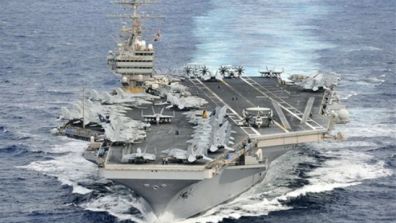
In this photo taken Dec. 16, 2011 and released by
U.S. Navy, its aircraft carrier USS Abraham Lincoln
(CVN 72) transits through the Pacific Ocean
US aircraft carrier USS ABRAHAM LINCOLN sails through Strait of Hormuz
WASHINGTON – The USS Abraham Lincoln on Sunday
passed through the Strait of Hormuz -- the first time a US aircraft carrier has
been through the strategic waterway since Iran threatened to close it earlier
this month.
The US Navy said the passage of the vessel was "routine" and had been
completed without incident
USS Abraham Lincoln (CVN 72) completed a regular and routine transit of the
Strait of Hormuz, Jan. 22, to conduct maritime security operations as scheduled
and in support of requirements set by the combatant commander," a statement from
Naval Forces Central Command said.
"The transit was completed as previously scheduled and without incident
videos ofo the uss abraham lincoln
http://www.youtube.com/watch?v=VAnA30Z6nD4
GREAT PHOTOS
http://www.youtube.com/watch?NR=1&v=tam-uIeJzFM&feature=endscreen
Iran has been threatening to shut down the Strait of Hormuz, a choke point
between the Persian Gulf and the Arabian Sea. The waterway is bordered to the
north by Iran, and its closure could cut off access to 20% of oil shipped around
the world, sending fuel
prices skyrocketing.
Why is Iran threatening to close it?
Iran has been under
increasing pressure to stop its
nuclear program. The European Union just approved
an embargo on Iranian oil Monday to punish the country. Iran insists it is
only working on nuclear power and medical research, but Western countries
believe it is trying to create a nuclear weapon.
To counter that pressure, Iran has played up its power over the strait. A
Revolutionary Guard commander was quoted in a Tehran newspaper saying government
leaders would not "allow a drop of oil" to pass through the strait if "our
enemies block the export of our oil."
MAP: Strait of Hormuz
Putting it even more boldly, "closing the Strait of Hormuz for Iran's armed
forces is really easy ... or, as Iranians say, it will be
easier than drinking a glass of water," Iran’s top naval commander said on
television in December. The country has also been test-firing missiles to show
control of the strait.
Why is this waterway vulnerable?
There are a few things that make the strait vulnerable. Its narrowest point
is only 34 miles wide. Oil tankers can only use one channel to come in and one
channel to come out, each of them roughly two miles wide. Iran has claimed
sovereignty over a few islands near the western entrance to the strait.
How would Iran close the strait?
Nobody is worried that Iran would actually put a barrier in front of the
Strait of Hormuz. "What most people think of -- and what the Iranians would
probably do -- is a combination of things that would not really close the Hormuz
Strait but make traversing it very difficult and risky so that people would not
go through," said Afshon Ostovar, a senior analyst at the nonprofit research
organization CNA
.
Iran could do that by using everything from mines to submarines to missiles
to small boats that harass ships. Political scientist Caitlin Talmadge outlines
one scenario: Iran could set mines in and around the shipping channels, then
attack from the air or the coast when people try to clear them.
INTERACTIVE: The world's oil
But Talmadge points out that the bluster from Iran makes any attempt to plant
lots of mines without being detected “essentially impossible.”
Could Iran really shut down the strait?
Many experts are skeptical that Iran could or would carry out the threat. In
a recent article for Foreign Policy Magazine, Ostovar dubbed it a
“kamikaze act” because Iran would be devastated by an all-out war with the
United States, which could be triggered by closing the strait.
Defense Secretary Leon E. Panetta called it a
“red line” that would spur the U.S. to react. Gen. Martin Dempsey, chairman
of the Joint Chiefs of Staff, says Iran could block traffic “for a period of
time,” but that the United States could reopen it the strait. U.S. officials
have said it could be done within a week.
Closing the strait would also
hurt Iran. Most Iranian imports and exports come and go by sea,
a report from the Institute of Near East and Gulf Military Analysis points
out. And Ostovar adds that stopping traffic in the strait would also harm Asian
countries that aren't among Iran's enemies, such as India and China.
However,
a new report suggests that the Iranian threat could become more real in a
decade or two. The U.S. has historically relied upon its allies in the Persian
Gulf region to provide bases from which it can deploy troops and get supplies.
Iran is now building weapon systems that could to stop that, possibly by
threatening governments that offer bases to the U.S. military.
Deploying lots of ground forces and bombers "worked for Operation Desert
Storm and for Operation Iraqi Freedom," said Mark Gunzinger, co-author of the
report from the Center for Strategic and Budgetary Assessments."We need to think
through -- what if we're not able to do that?"
If closing the strait is an extreme or unlikely step, what else could
Iran do?
Iran has a wide range of other ways to use its power in the gulf, from
seizing ships to raiding facilities offshore. It can also use small ships to
damage or detain tankers or board merchant ships to slow down shipping,
harassment that falls short of war. Those minor attacks could reduce traffic or
raise insurance costs for shippers. And those attacks don't need to be at or
near the Strait of Hormuz.
“Everyone uses
‘close the gulf’ as sort of a slogan,” said Anthony Cordesman, a strategy
expert with the Center for Strategic and International Studies. “But Iran has
demonstrated that it would look at a whole range of different ways to put
pressure on the Arab Gulf states and the West.
“It wouldn’t make any sense at all for Iran to concentrate all of its assets
around one narrow point and make it extremely easy to attack them,” he added.
RELATED:
European Union bans Iranian oil
U.S. aircraft carrier sails through Strait of Hormuz
Tensions rise between Iran, Arab states over possible oil embargo
-- Emily Alpert
Let’s Hope Iran Tries To Close The World’s Oil Spigot
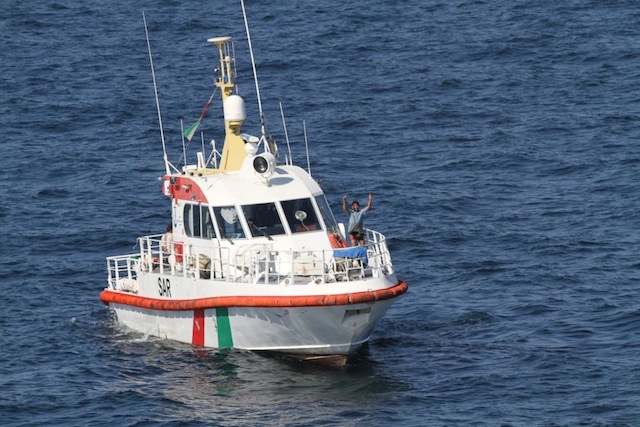
An Iranian mariner waves to his rescuers on the
U.S.S. Oscar Austin in the Persian Gulf, Nov. 18. Photo: DVIDS
What keeps the U.S. Navy’s top officer awake at night? “The Strait of
Hormuz,” Adm. Jonathan Greenert confessed during a speech on Tuesday morning.
Greenert meant that he’s worried Iran will close one of the planet’s most
strategically important waterways, through which about 20 percent of the world’s
oil flows. The Iranians have spent weeks threatening to do just that.
Greenert is certainly right to worry, especially as
the U.S.S. John C. Stennis‘ battle group
just passed through the strait. But in a sense, he
should hope Iran tries to close the Strait of
Hormuz. There are few mistakes Iran could make that
would be worse for it in the long run.
Why? Because Iran would suddenly be responsible for
sending world energy prices skyrocketing — perhaps to
$200 a barrel — after a disruption of Gulf oil
shipping. Washington usually has a hard sell when
convincing other countries that Iran’s regional
bellicosity and lack of transparency on its nuclear
program merits a tough response. But when Iran hits the
entire world in the wallet, the argument gets
substantially easier.
Especially when making that argument in Beijing. The
Chinese, in need of Mideast oil to propel their economy,
often try to
temper hostilities between the U.S. and Iran, lest
regional instability stops the flow of crude. Usually
that expresses itself in terms of restraining
Washington. But if Iran is unilaterally responsible for
the oil flow stopping, just watch Beijing move out of
Washington’s way for harsher sanctions. Who knows: maybe
China would even get on board with an American push to
forcibly reopen the strait if Iran keeps it closed.
(Although, as Gen. Martin Dempsey, the chairman of the
Joint Chiefs of Staff has observed, Iran probably
lacks the naval capability to block sea traffic
through the strait for extended periods.) The last time
the oil flow through the strait was disrupted, during
the Iran-Iraq war of the 1980s, the Chinese armed Iran
against aggressor Iraq.
If anything, Iran’s closure of the strait would
probably play like its old enemy Saddam Hussein’s 1990
decision to invade Kuwait. Before the invasion, world
governments might not have liked Saddam, but
most of them didn’t consider him an implacable threat to
regional stability (and, hence, their economic
interests). Afterward, the world viewed him as a rogue
who needed to be confronted.
And one of Iran’s biggest strategic assets is a
perception that the U.S. bullies it. That narrative is
already taking a beating, thanks to Greenert’s Navy and
the Coast Guard, which have now saved two
Iranian vessels in
five days, even as Iran issues its threats. The more
Iran acts as an aggressor — and in particular, in a
manner that harms the interests of those outside
Washington, Jerusalem, or the Arab Gulf states — the
more it squanders its advantage.
None of this to say any military confrontation with
Iran is desirable; it would probably be a
bloody disaster, especially if the U.S. turned it
into a full-fledged war with more expansive goals than
re-opening the waterway. The point is that Iran has more
to lose than to gain by closing the strait. Shutting it
would be another sign of Iran’s tendency to shoot itself
in the foot — just like with the crazy-if-true story
about its
elite Qods Force trying to assassinate a Saudi diplomat.
But outright confrontation may not even be the most
lasting damage Iran sustains. China is one of Iran’s
biggest trade benefactors. Now that Washington
loosened Russia from Iran’s orbit, Iran doesn’t have
any big, powerful friends left. Screwing with oil prices
means screwing with China — which might make Beijing
rethink its entire relationship with Iran after any
crisis in the strait, from its economic ties to its
diplomatic blocking and tackling over the Iranian
nuclear program. Maybe it should be Mahmoud Ahmadinejad,
not Adm. Greenert, who should have some restless nights
thinking about the strait.
AbilShowdown
at the Strait of Hormuz
ity
of Iran to hinder shipping
January 24, 2012
BY aRHUT hERMAN
The build-up of the crisis in the Strait of Hormuz took
another big step this weekend, when the aircraft carrier USS
Abraham Lincoln entered the Persian Gulf together with British
and French naval escorts — defying Iran’s warnings not to send
another carrier there.
The Lincoln is there in case Iran tries to make good on its
threat to close that vital international waterway in response to
harsh new US and European Union sanctions against the radical
Islamicist regime. What happens next in this high-stakes game
depends on three people.
One of them is President Mahmoud Ahmadinejad of Iran. The
second is Premier Wen Jiabao of China, who’ll have to decide
whether his country is ready to join those sanctions — and by
doing so, put the last nail in Tehran’s economic coffin.
The third is President Obama. How he responds to what happens
in the Gulf could decide the future shape of the Middle East —
not to mention his own re- election.
A dozen supertankers a day and one-third of the world’s
seaborne oil pass through the strait. For Ahmadinejad, trying to
close it (with mines, anti-ship cruise missiles, midget subs and
swarms of suicide attack boats) is a war Iran is bound to lose,
given America’s overwhelming military power in the region. Nor
will his threats stop the EU from going ahead with sanctions.
No, his most likely intended audience is far to the east in
Asia, where economies thrive or wither depending on the flow of
oil coming out of the Gulf.
The most important of those is China, which imports 35
percent of its oil needs through the Gulf, including 12 percent
from Iran. In exchange, Beijing has given Tehran advanced
missile technology, turned a blind eye to Iran’s acquisition of
key nuclear-weapons technology from Chinese sources and blocked
any tough UN anti-Iran sanctions.
But now Beijing is under pressure from the United States and
Europe to end its oil imports from Iran and join the campaign to
halt Tehran’s relentless hunt for a nuclear bomb. In December
alone, it cut that import total by nearly half.
But Wen and his colleagues worry about what happens if they
go on an Iran-free oil diet. Before he commits to the full court
press of sanctions, Wen has been meeting with Arab leaders
around the Gulf to make sure oil from the Saudis and the Arab
Emirates will make up for any shortfall.
Meanwhile, his other eye is on the Strait of Hormuz, as is
Japan’s. Any major disruption there will make them think twice
about supporting any sanctions, even if it means Iran gets its
bomb.
Here’s the dangerous part — and where President Obama comes
in.
Even if Iran loses a military confrontation with the United
States in the Hormuz Strait, it wins. Tehran can hope that
disrupting tanker traffic, even for just a few weeks, and
driving up oil prices in the meantime, will convince China and
the rest of Asia that sanctions are as deadly a threat to their
economy as to Iran’s.
The only way to prevent that is for President Obama to make
it clear that, by closing the strait, Ahmadinejad will doom the
Islamic Republic. Only if China and the rest of the world
believes such a closure could never happen again, will Iran’s
threat to international stability finally come an end.
But will Obama do it? There are no easy military solutions
for regime change in Iran. Certainly Ahmadinejad is betting that
our commander-in-chief won’t use a confrontation in the strait
as a pretext for taking out Iran’s nuclear sites, let alone
regime change.
Indeed, Obama would know that forcibly reopening the strait
would be enough to make him look like the reincarnation of
Dwight Eisenhower in time for the 2012 election. But that
“victory” might also be enough to panic both Asia and possibly
Europe, and wreck any effective sanctions.
Then the world and the Middle East becomes a very dangerous
place. A nuclear-arms race in that volatile region becomes
inevitable, and Iran — home of state-sponsored terrorism and the
yearning for a second Holocaust — looks more impregnable than
ever.
The fate of the strait hangs by a thin thread of oil. It’s up
to our president and the Navy to make sure that oil flows — and
that any regime threatening to cut it never does.
Arthur Herman was a Pulitzer Prize finalist in 2009. His
new book, “Freedom’s Forge,” is due in May.
FROM;
http://www.nypost.com/p/news/opinion/opedcolumnists/showdown_at_the_strait_of_hormuz_ZWlYSnTlgapPXXOuCf73OK
SEPTEMBER 2012
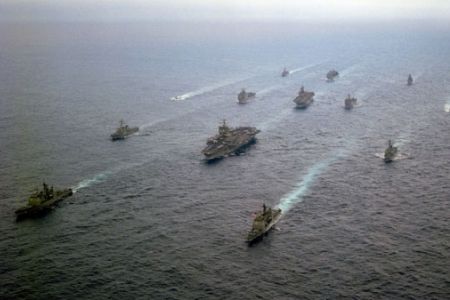
The U.S. is leading its
largest-ever war games near Iran by sending battleships,
aircraft carriers, minesweepers and submarines into the Persian
Gulf.
25 countries are
participating in the 12-day war games exercise with the United
States, Britain, France, Saudi Arabia and the UAE deploying the
largest number of warships. Fleets of warships will flood the
Strait of Hormuz, the important waterway through which 40
percent of the world’s seaborne oil passes, as a show of force
to deter Iran from trying to close the straits or retaliate
against U.S. assets in the region, even in response to an
unprovoked Israeli strike.
Despite the
unprecedented scale of the operations, chances of a U.S. or
Israeli strike on Iran have lessened considerably in recent
weeks, as American refusal to back an Israeli strike have turned
the tide of war-hawks in Israel. Israeli Prime Minister Benjamin
Netanyahu remains one of the few still advocating harsher
postures, and he is increasingly isolated.
A torrent of military
and intelligence analysis rejecting the need or viability of a
preventive strike on Iran have come out in recent days. A report
by dozens of former government officials, national security
experts and retired military officers released Thursday
concluded military action would
spark an uncontrollable regional war and have
counterproductive results. Antiwar
Following the
reports of the armada of U.S. and British ships amassing in
the Persian Gulf, a top commander in Iran’s Revolutionary
Guard warned Sunday that “nothing will remain” of Israel if
his country is attacked. Gen. Mohammad Ali Jafari said Iran
would close down the Strait of Hormuz and strike U.S. bases
in the Middle East. Prison Planet
Retired U.S. General
John Abizaid has previously described the Iranian military
as “the most powerful in the Middle East.”
A bipartisan group
of ambassadors, retired generals and foreign policy experts
is warning against a U.S. or Israeli attack on Iran's
nuclear facilities. WSJ
Not a war of weeks
or months, but a “generations-long war” is how no less a
figure than former Mossad chief Efraim Halevy describes the
consequences of open conflict with Iran. In comparison with
Iraq and Afghanistan, both countries with relatively small
populations which were already in a state of relative
powerlessness before they were invaded, Iran commands the
eighth largest active duty military in the world, as well as
highly trained special forces which operate in countries
throughout the region and beyond. The Nation
U.S. wars of
“invasion, aggression and occupation” are no longer
sustainable economically and socially, veteran war critic
and U.S. scholar Professor Bill Ayers, says. He adds that if
NATO, the U.S. or Israel attack Iran, it would lead to a
catastrophe. RT
ISH/HJ
The aggression show of force is the biggest
such military exercise ever taken in the Persian Gulf,
escalating tensions in an uneasy region
by John Glaser, September 15, 2012
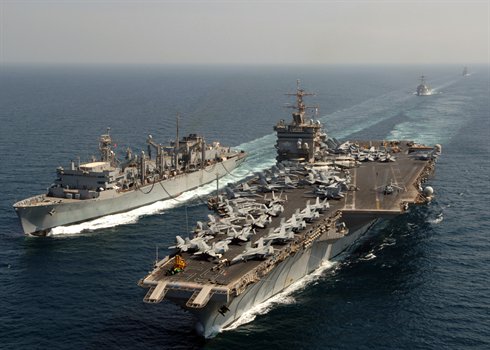
Battleships, aircraft carriers, minesweepers and submarines from
25 nations
are swarming into the Persian Gulf, in the largest such
military exercise ever undertaken in the region, as concerns of
a looming Israeli strike on Iran still linger
Countries leading the massive war games exercise inlcude the
United States, Britain, France, Saudi Arabia and the UAE. Fleets
of warships will flood the Strait of Hormuz, the important
waterway
through which 40 percent of the world’s seaborne oil passes,
as a show of force to deter Iran from trying to close the
straits or retaliate against US assets in the region, even in
response to an unprovoked Israeli strike.
Despite the unprecedented scale of the operations, chances of
a US or Israeli strike on Iran have lessened considerably in
recent weeks, as American refusal to back an Israeli strike have
turned the tide of war-hawks in Israel. The Prime Minister
Benjamin Netanyahu remains one of the few still advocating
harsher postures, and he is
increasingly isolated.
A torrent of military and intelligence analysis rejecting the
need or viability of a preventive strike on Iran have come out
in recent days.
A report by dozens of former government officials, national
security experts and retired military officers released Thursday
concluded military action would
spark an uncontrollable regional war and have
counterproductive results.
“We do not believe it would lead to regime change, regime
collapse or capitulation,” the report says, adding that an
attack would increase Iran’s motivation to build a bomb, in
order to deter further military action “and redress the
humiliation of being attacked.”
The US has made it clear to both Israel and Iran that a
military strike is not imminent. “I suspect the Americans have
given quiet assurances through indirect channels that they have
no intention of moving into Iranian national waters,” Scott
Lucas, an Iran expert at Birmingham
University in England,
said.
“Both sides have good reasons to avoid a conflict – they have
other issues to deal with right now.” Still, the war games do a
good
job of escalating tensions in a very uneasy region.
October 5, 2012
Military strategists appear to have missed a foreseeable
outcome in their efforts to pressure Iran.
As the temperatures are rising in the Mideast, as reader
chatter about Turkey’s involvement in Syria attests, a Financial
Times article describes how the success of economic sanctions
against Iran have strengthened its ability to make credible
threats to restrict oil shipments.
Market participants have long discounted the idea that Iran
would restrict the flow of oil through the Strait of Hormuz, a
comparatively narrow channel though which 35% of the world’s oil
supplies pass. Threatening cargo ships would also interfere with
Iran’s own oil shipments, far and away its biggest source of
foreign exchange, and critical food imports.
But that dynamic has now changed. As
the Financial Times notes (hat tip Scott):
Sanctions imposed over Iran’s nuclear programme have
grown tighter, and the effects are being felt across the
country. Fears are rising that Iran’s leadership, facing
increasing domestic unrest over spiralling inflation, has
less and less to lose through brinkmanship in the channel
now that its own oil income is being squeezed to a trickle.
For years, oil traders were inured to rhetoric from Iran
that it stood poised to shock world energy markets by
blocking the seaway in retaliation for sanctions or an
Israeli attack. They were sceptical it would engineer a
crisis in a region so critical to its own economic survival.
But Iran’s plummeting oil exports mean that a cornered
Tehran could see a confrontation in the strait as less an
act of self-immolation and more a calculated gamble.
It’s a bit disingenuous to put responses to sanctions in the
same boat (no pun intended) as a military attack. Israel and the
US have been saber-rattling at Iran for years; it’s hard to
imagine that Iran would not engage in an aggressive retaliation,
and either blocking the strait or launching strikes on cargo
ships is a blindingly obvious move (it’s not as if Iran’s
enemies aren’t going to be interfering with its shipments at
that point). Readers have also pointed out that Saudi refineries
are within easy strike distance.
Saudi Arabia and Abu Dhabi have opened new pipelines that
will considerably reduce the importance of the Strait of Hormuz,
but they won’t be operating at full capacity for 18 months. And
even then, the new facilities don’t neuter the Iranian threat,
but merely make the effects somewhat less severe. So Iran still
has considerable leverage as well as motive to act. And
remember, even though Iran has always insisted it would respond
fiercely to an onslaught, as opposed to be an aggressor, it has
means for applying pressure that fall short of an attack. Again,
from the FT:
Fearing Mr Ahmadi-Nejad could seek a diversion through
international sabre-rattling, policy makers say that Iran
could easily find ways to disrupt world energy supplies
without a direct attack. Some argue it could board every
supertanker transiting its territorial waters under other
pretexts, such as inspecting for weapons smuggling. Others
fear it could even use proxies to fight its war, with
terrorist organisations carrying out attacks. Those actions
would both slow oil flows and push up prices. Tehran would
win a double victory: continuing its own remaining oil sales
while benefiting from higher prices. Amrita Sen, senior oil
analyst at London-based Energy Aspects, says that domestic
pressure and economic collapse could force Tehran back to
the negotiating table over its nuclear programme. “But, on
the other hand, it also makes more likely a provocative
action by Ahmadi-Nejad.”
Since the West does not have a good direct response to this
basic problem, it is sending more men and material into the
region:
Seeking to counter Iran’s influence, many nations are
building up their military presence in the Gulf. September’s
drills involved dozens of warships from, among others, the
US, the UK, Japan, France, New Zealand, the Netherlands,
Italy, Australia and Canada. Lieutenant Greg Raelson, a
spokesman for the US fifth fleet, which often keeps one of
its aircraft carriers in the Gulf, stressed the Strait of
Hormuz was critical to “fuel economies around the globe”.
And protection does not come cheap:
It is almost impossible to calculate the cost of policing
the Gulf but Sherife AbdelMessih, chief executive of Future
Energy Corporation, provides a back-of-the-envelope
approximation: that the US spends roughly $90bn on its
Bahrain-based fifth fleet or about $15 per barrel that
crosses Hormuz.
Now we know why Obama is so keen to talk about fracking. It
solves more than one problem.
THIS BLOG CONTINUES ON PAGE 119
2011 INDEX
2012 INDEX
JAN, FEB, MAR, APR 2012
MAY, JUNE, JULY, AUG 2012
SEPT, OCT, NOV, DEC. 2012
http://www.greatdreams.com
http://www.earthmountainview.com






